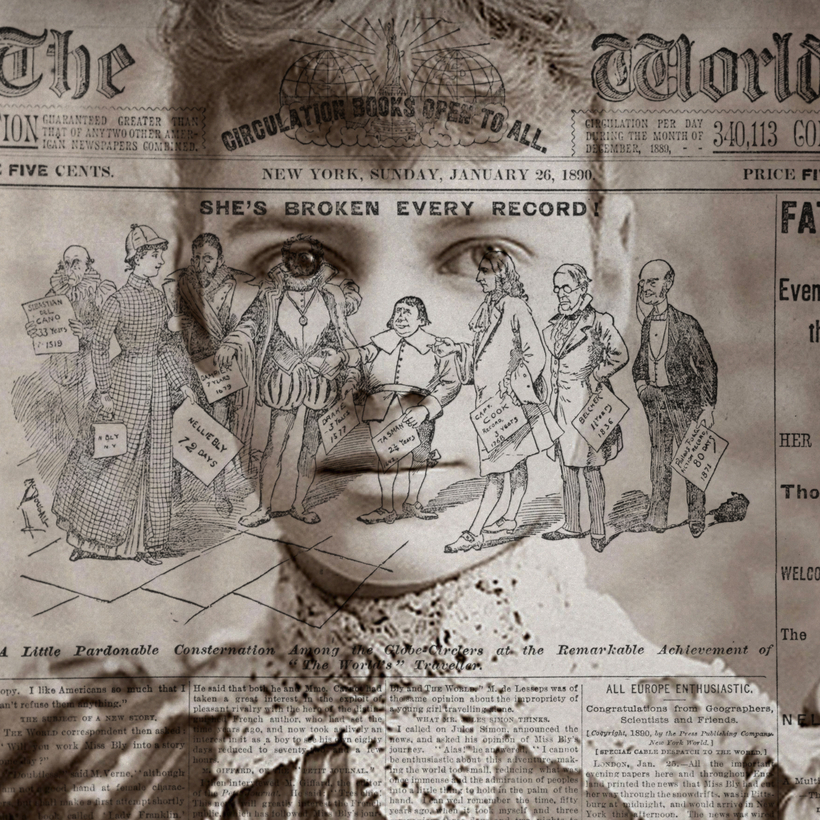Long before Gloria Steinem put on rabbit ears and a drum-tight satin corset to chronicle life as a Playboy bunny in a two-part series for Show magazine in 1963; before journalist Barbara Ehrenreich worked a slate of menial jobs to see if she could live on a minimum wage, heavy lifting that formed the basis of her 2001 book, Nickel and Dimed: On (Not) Getting By in America; before Torchy Blane and Lois Lane and Brenda Starr, there was doughty Nellie Bly feigning madness to expose the horrors at a New York City insane asylum. Bly, Elizabeth Banks, Eva Gay, Eliza Putnam Heaton, Elizabeth Jordan, Victoria Earle Matthews, Nell Nelson, Winifred Sweet, and Ida B. Wells are among the journalists who populate Kim Todd’s Sensational: The Hidden History of America’s “Girl Stunt Reporters.”
In the late 19th century, opportunity knocked for ambitious female journalists who had no interest in the society beat. The publishers of big-city dailies, such as Joseph Pulitzer at the New York World and William Randolph Hearst at the New York Journal, were looking to beef up circulation and to best the competition; meanwhile, the influx of immigrants into the U.S. promised a whole new audience.
Then as now, editors couldn’t go wrong with the seamy, with the scandalous, and with something new—in this case, long-form, firsthand accounts by women reporters often going undercover to reveal society’s ills and inequities. “Hearst, though he didn’t pontificate about women in journalism, would do whatever it took to win,” writes Todd. “Female writers equaled sales.” So, hey, big boy, get them re-write.
Vanishing Ladies
In late 1888, a young woman, known simply as the “girl reporter,” pretended to be pregnant and walked the streets of Chicago going from doctor to doctor to doctor (200, all told) to see who among them would be willing to perform an abortion; you could read all about it in a month-long series in the Chicago Times.
Eleanor Stackhouse, who wrote under the name Nora Marks (most of the stunt reporters used a pseudonym or two), managed to get hired on at a meatpacking plant in order to report on the grotesque working conditions. Eliza Putnam Heaton traveled from Liverpool to New York in steerage to document the immigrant experience. Kate Swan McGuirk told of a pharmacist who illegally dispensed opium. And Helen Cusack, operating as Nell Nelson, posed as a shopgirl, an experience that was the basis for her Chicago Times series “City Slave Girls.” Later, she laid bare sweatshop conditions in “They Work in an Inferno” for The New York World.

Such exposés raised hackles and awareness in equal measure. The Buffalo Daily Times harrumphed that the “girl reporter” who wrote about her search for an abortion “must be ‘lost to shame and womanly feeling,’” while others were grateful for the information. Nell Nelson’s accounts inspired investigations and debates about labor reform.
Eliza Putnam Heaton traveled from Liverpool to New York in steerage to document the immigrant experience.
But for some women journalists, stunt reporting, while lucrative (and a way to get their foot in the door), could also be embarrassing, if not flat-out degrading. At one point in her career, Elizabeth Banks found it tough to land paying work that didn’t involve, say, getting arrested as a prostitute and spending the night in jail.
When Eleanor Stackhouse first began writing for the Chicago Tribune, she was sent out to apply for work to a publisher of pornographic books. A certain male editor, it was rumored, assigned a cub reporter to marry a Mormon and send back dispatches from Salt Lake City. But he had nothing on the editor who suggested a female reporter sail from Europe to New York and let herself be kidnapped by one of the gangs that preyed on immigrant girls. Still, as Todd notes, for women of the era, “this life was more free than almost any other option.”
It’s sometimes hard to keep the stunt reporters and their exploits straight in Sensational. Was it Helen Dare (nom de stunt: Elizabeth Tompkins) who rode 40 miles down a log flume in the Sierras, or was it Elizabeth Banks? (Tompkins.) Was it Kate Swan McGuirk who went through the experience of having herself strapped into the electric chair, or Eva Gay? (McGuirk.)
And Todd sometimes seems to be an ardent member of the “Leave no detail out,” “Let no scrap of research go unused” school of journalism. Her account of the faux-pregnant “girl reporter,” for example, leads to a potted history of abortion in the U.S., while McGuirk’s jailhouse interview with Lizzie Borden, recently accused of killing her father and stepmother—she was McGuirk’s former schoolmate—segues rather bafflingly into a discussion of women jurors.
Still, Todd has great affection for these women and celebrates their triumphs while placing them in historical context. And she argues trenchantly against long-accepted accounts of the origins of creative nonfiction, later to be known as New Journalism.
Compared to Bly and her cohorts, Hunter Thompson was strictly a gonzo-come-lately.
Joanne Kaufman is a New York–based journalist and critic


